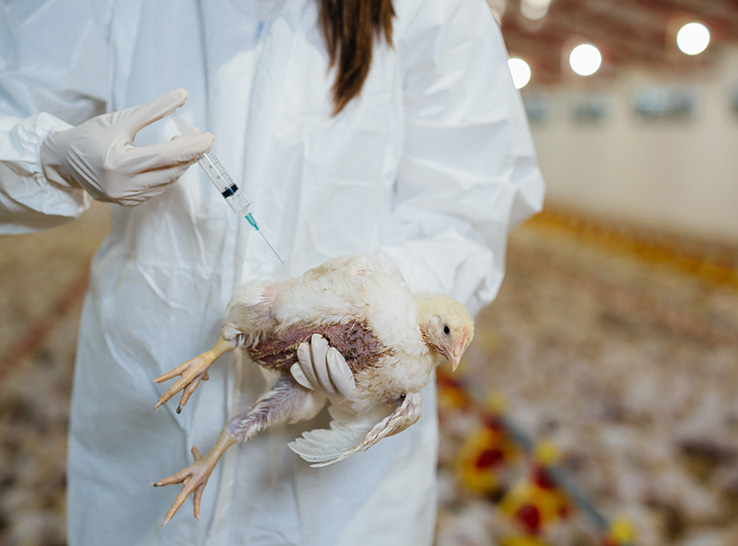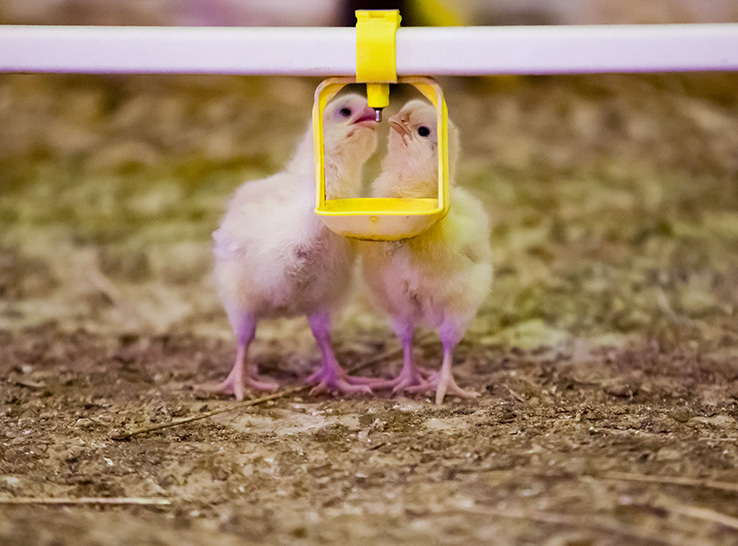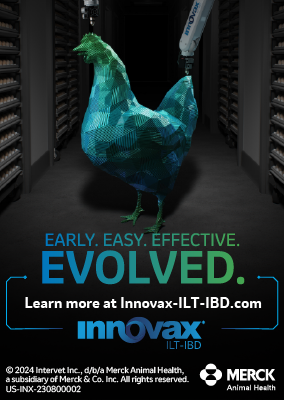Third in a series
Getting chicks off to a quick start in the brooder house is always a priority, but it is especially critical when birds have been vaccinated for coccidiosis.
Live vaccines deliver a controlled, balanced dose of Eimeria oocysts to stimulate the flock’s natural immunity to coccidiosis. Healthy, active chicks exploring their environment naturally shed and re-ingest more vaccinal oocysts — a process that accelerates immunity to the costly protozoal disease.
“We need to help chicks make a smooth transition by setting up a comfortable environment with ample feeder space for everyone to eat,” says Charlie Broussard, DVM, Merck Animal Health. “We like to say that you can’t provide too much feed early on.”
Water also drives feed consumption, so it’s important to monitor the chicks that first day to ensure they find the water. “Some farms put paper down so the nipples’ drips make a sound to attract the chicks,” he adds. “They need to find the water for a good start. If they don’t drink, they won’t eat.”
Flow rates that are too high for young chicks will discourage them from drinking. It’s therefore critical to monitor water levels daily and adjust flow rates as the birds grow.
Use supplemental feeders for a fast start
“Supplemental feeders ensure young birds get a good start in their new environment by making it easy to access feed,” Broussard says.
The key is to keep supplemental feeders (feeder lids) in place until chicks are at least 10 days of age and ready to transition to the full house. Even then, moving supplemental feeders from the brood area to the new space will encourage birds to migrate into the full house. Continue to provide some supplemental feeders until birds are fully acclimated to the standard house feeders, the veterinarian notes.
When it’s time to remove supplemental feeders, Broussard recommends doing it gradually to minimize stress and avoid mortality spikes.
“If you removed the supplemental feeders and the chicks sit in the feeder pans to eat, then you removed the lids too soon,” he explains. “That activity also limits feed access for other birds.”
The fecal-oral route, of course, is how chicks are re-exposed in the chicken house to live coccidial organisms that help to stimulate natural immunity to coccidiosis. However, limited feed access can cause excessive litter eating. Not only is this not nutritionally sound, but the litter may contain high levels of bacteria such as Clostridium spp., which can lead to necrotic enteritis (NE) and reduced flock performance and uniformity.
Broussard also recommends avoiding feed changes during peak coccidial vaccine cycling (every 7 days) to ensure birds keep eating. For example, do not transition from starter feed to grower feed at 14 days of age.
To determine whether birds are eating and drinking sufficiently, he suggests checking crop fills at 24 and 48 hours after placement. It may be necessary to add supplemental feeders or waterers. Full-crop targets are 95% at 24 hours and 100% at 48 hours post-placement, Broussard points out.
Check the nipple-drinker height and water pressure — not only to accommodate the bird, but also to avoid excessive moisture under water lines and keep the litter dry. Although water-line sanitation helps keep the birds healthy through the grow-out period, avoid treatments during the second and third oocyst-exposure cycles.
Ration formulation: Get the right mix
Tweaking feed rations to maximize growth patterns of vaccinated birds will help minimize secondary bacterial challenges that could induce NE (necrotic enteritis).
“When creating these rations, consider the early protein requirements of vaccinated birds, especially the sulfur amino acid levels,” Broussard says. “Data analysis suggests improved levels of total sulfur amino acids during the first 2 to 3 weeks of life may be linked to better performance in broilers receiving Coccivac®-B52 vaccine.”
Extra attention to diets in those early days will pay off in the end. Coccidiosis vaccination may disrupt bird growth temporarily, but fortifying diets with fat-soluble vitamins (D and E) during peak vaccinal-oocyst cycling may improve bird performance. For starter feeds, consider supplementing vitamin E at 40,000 to 60,000 IU.
It’s worth repeating that in-feed anticoccidial medications should not be used during the first 2 weeks post-vaccination, as it can disrupt cycling of vaccinal oocysts. Using feed additives with anti-clostridial activity will help reduce incidence of NE during the immunity-building phase of the vaccination period, Broussard notes.
Avoid extremely low-protein diets from day 28 through slaughter, which may impact “compensatory gain” — a period of rapid growth needed to make up for the short-term impact of the vaccine. “That’s about the time broilers are laying down breast meat, and you don’t want to shortchange that process,” he adds.
A word about NE
Many factors can influence NE development. To preserve gut integrity and keep birds healthy and growing, it’s important to monitor the digestibility of raw materials, especially in starter feeds.
For example, wheat, bakery meal, distillers’ dried grains with solubles, barley or rye can irritate the gut and cause NE. “But there are enzymes you can add to the diet that can help improve ingredient digestibility and minimize NE incidence,” Broussard says.
Dietary calcium, phosphorus and phytase may impact the natural NE cyclic pathway. “Pay special attention to calcium source, type, size and inclusion level within the diet,” he adds. “Research suggests that dietary calcium level may influence NE-associated mortality.”
Monitor feed milling and delivery
Ensuring the right feed gets to the right birds is especially important during the coccidiosis vaccine re-exposure period. Not only does it impact gut health and bird development, but supplying medicated feed at the wrong time in the production cycle will wipe out coccidiosis-vaccination efforts.
“Good communication between live-production and feed-mill personnel is essential when starting a coccidiosis vaccination program to ensure that non-medicated starter feed is delivered to the correct farms,” Broussard says. This includes establishing a feed-delivery schedule to prevent last-minute orders and placement changes.
Keep feeds that contain anticoccidials separate from unmedicated feeds in storage bins, delivery vehicles and on the farm. Due to limited finished-feed storage, some mills may require delivery of medicated starter diets to farms before beginning production of unmedicated starter feed. This situation needs to be addressed ahead of time as part of the overall feed mixing and delivery schedule.
“Keep a close watch over flocks that receive an accidental feed delivery containing anticoccidials during the 3-week period following coccidiosis vaccination because there is the potential for a coccidiosis break,” Broussard notes. “This scenario may warrant keeping the flock on an anticoccidial ration for the duration of the grow-out period.”
Matching the diet to the birds’ growth phase and providing proper feeder and waterer access for all not only impact the birds’ performance but also the success of a coccidiosis vaccination program.
For more tips and insights for managing coccidiosis, go here.
Other articles in this series:
Don’t overlook the basics when using coccidiosis vaccines
Coccidiosis vaccination: Are you creating an environment for success?
Veterinarian offers tips for monitoring effectiveness of coccidiosis-vaccination program
Coccidiosis vaccine checklist: Tips for maximizing performance
Editor’s note: Content on Modern Poultry’s Industry Insights pages is provided and/or commissioned by our sponsors, who assume full responsibility for its accuracy and compliance.









